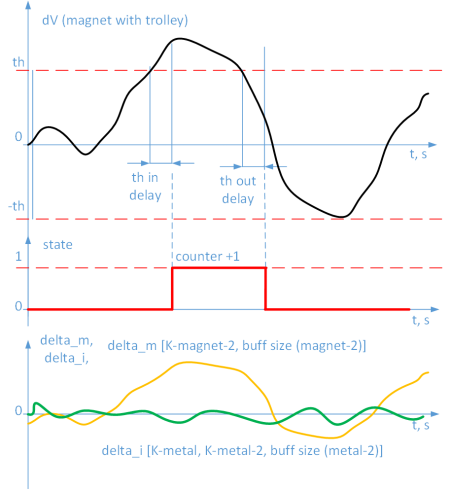Magnet with trolley detector configuration
Parameter group "magnet with trolley"
The system responds to a change in the magnetic field in the sensor's operating range. At the same time, the activation of the magnet is blocked if the metal is simultaneously detected. These functions are intended for detecting magnets when used on an object (for example, cash registers of hypermarkets), in the area of operation of a system of trolleys with an iron structure, since iron has the properties of a magnet.
These parameter groups allow you to adjust the detection of magnets during metal compensation.
- dV - the overall response of the system to the magnetic field with metal compensation
- th - sensitivity detection setting. The parameter values are selected based on the noise level (0.25 ... 10.0)
- K-magnet-2 - the parameter of taking into account the rate of change of the magnetic field
- K-metal, K-metal-2 - the parameters of accounting for changes and the rate of change during the movement of the metal
- Buf size (magnet-2) - the size of the history buffer (5 - corresponds to 0.05 sec) for the analysis of changes in the magnetic field
- Buf size (metal-2) - the size of the history buffer (10 - corresponds to 0.1 sec) for analysis of changes during the movement of metal
- th in delay / th out delay - time setting for detection when dV is exceeded above th and at detection loss at dV is less than th
- delta_i - the indicator variable of the changes during the movement of the metal
- delta_m - indicator variable of magnetic field changes
- state - the state of detection of the magnet with trolley
- counter - the the lifetime magnet events counter.
Figure 1 shows an example of the change in the state of the detection of a magnet (state) in time, depending on the indicator value (dV) and the influence of the tuning parameters (th, th in delay, th out delay).
Adjustment of the parameters for the detection of magnets during metal compensation
1. The settings of this functionality assumes that the metal detector and magnet detector A (magnet-A) were previously set up and operate.
2. To estimate the level of the magnet's influence, use the variable dV, which should be included in the monitoring mode.
In the beginning, the system is tuned to the best sensitivity for a magnet using th, buf size (magnet-2), K-magnet-2, (K-metal = 0, K-metal-2 = 0), taking into account the noise level.
The magnet detector is evaluated using the state and counter variables, as well as on the basis of the external LED indication (red). If metal compensation is not needed on the object, then the adjustment is completed and thus the system will react to the magnet with the help of sensors A, B independently.
After the settings, save the settings.
3. If it is necessary to adjust the metal compensation when transporting the trolley, the parameters K-metal, K-metal-2, buf size (metal-2) are selected so that the system does not react to the magnetic field of the trolley when it moves.
At the same time, the system should compromise on the magnet that is in the person, which pushes the trolley ahead of him.
Separately, the effect of metal and magnet can be estimated using the variables delta_i and delta_m in the monitoring mode.
If necessary, adjust th, th in delay / th out delay.
After the settings, save the settings.
4. The device can send information about the number of saves of the magnet detector over the period or the message about the operation based on the counter and state variables to account for the statistics of the alarms and synchronization with the video surveillance systems.
To do this, you need to set these variables as streams with the necessary parameters and save the changes.
